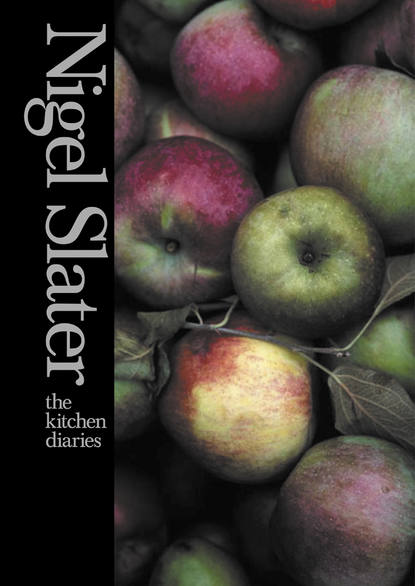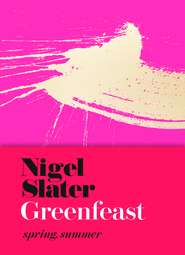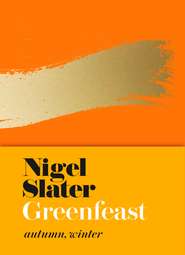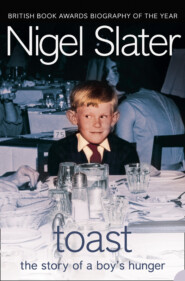По всем вопросам обращайтесь на: info@litportal.ru
(©) 2003-2024.
✖
The Kitchen Diaries
Настройки чтения
Размер шрифта
Высота строк
Поля
I feel that buying ingredients as fresh, as honest as this is a chance to cook them as simply as possible, to let the food taste of itself, to allow it to be what it is.
The kitchen
My kitchen is not large, but a trio of skylights and the fact that the doors open up to the garden make it a hugely pleasurable place in which to cook. It has no fancy cookers, no batterie of expensive equipment, yet it has been thoughtfully and intelligently designed. The space works perfectly. Good kitchens are not about size, they are about ergonomics and light.
The garden
My garden is a tiny urban space, yet it has been crucial to this book. Leading down from the kitchen doors are steps on which rest pots of thyme and single marigolds, dark red pelargoniums and Italian aubergines. There is an old stone terrace where we eat in summer round a zinc-topped table set under a fig tree. The terrace makes way for a small, rather amateurish potager, with six little beds filled to overflowing. Two for pot-herbs, roses and old-fashioned scented pinks, one each for raspberries and currants, another for tomatoes and courgettes and one for runner beans, broad beans, artichokes and rhubarb. In amongst the chaos grow sweet peas, dahlias, nasturtiums and opium poppies.
Beyond that is a miniscule wooded patch, no deeper than twelve feet, with a tangle of plum, damson, hazelnut and quince trees, plus wood strawberries and, in winter, snowdrops growing underfoot. What I should emphasise is just how small this garden is. So when I refer to the ‘kitchen garden’, I am talking about a diminutive patch probably about the same size as the average allotment. I make no attempt to be self-sufficient, I simply haven’t the space. It is just that by growing something myself, from seed or a small plant, I feel closer to understanding how and when a pear, a medlar, a broad bean or a raspberry is at its best.
Anyone who has ever grown anything for themselves, or simply has an old apple tree in the garden, will know that you often end up with a glut – too much of the same ingredient at the same time. I was keen to reflect this in The Kitchen Diaries, so there are months where there may be a bounty of tomato recipes, others where almost every week seems to feature raspberries in some form or another. If you make the most of the good prices that go hand in hand with a glut at the market, or you want to use every bit of the ripe fruit and vegetables in your garden, then you will welcome this. Personally, I think of it as something of a glorious seasonal feast.
Roast rhubarb on a January morning; ‘pick-your-own’ strawberries in June; a piece of chicken on the grill on an August evening; a pot-roast pigeon on a damp October afternoon; a pork feast in November. This is more than just something to eat, it is food to be celebrated, food that is somehow in tune with the rhythm of nature. Quite simply, the right food at the right time.
january
Dal and pumpkin soup (#ulink_5570d654-4723-5b09-b08c-943b353f6190)
A salad of fennel, winter leaves and Parmesan (#ulink_4e007ff1-e093-5d48-b694-602fdedf1865)
Stew (#ulink_9dc8fd32-22e3-5704-8234-3590c1c9ec91)
A frosted marmalade cake (#ulink_a3ecfd05-ef25-520c-b74e-a615feb930a2)
Frozen yoghurt with roast rhubarb (#ulink_ff3314af-8286-5308-b022-677e526bba6e)
Double ginger cake (#ulink_fb0d1e61-df2b-5e41-a652-733a88a6b973)
Onion soup without tears (#ulink_59a2deed-5b1c-5d7c-b60a-cc963a17272e)
Cheese-smothered potatoes (#ulink_8dffd93c-3ae0-5628-b40c-5f15a2c3d248)
A velvety soup for a clear, cold day (#ulink_7ffd3a38-3336-59f3-8a1d-4e6461acf605)
Bulghur wheat with aubergines and mint (#ulink_bdd3e2dd-72e4-57e0-8a57-53234f502dfe)
A really good spaghetti Bolognaise (#ulink_d2573481-7bb5-51b5-b850-adf302e06d68)
Chicken broth with noodles, lemon and mint (#ulink_8deea606-60a1-566b-960f-8a375537cf29)
Spiced crumbed mackerel with smoked paprika (#ulink_8373438e-f451-5f8a-aa3a-ee96fb086cfe)
A herb butter for grilled chops (#ulink_80f2024e-93e1-599a-bb0f-e722006ecb8c)
A pot-roast pheasant with celery and sage (#ulink_522a7832-c942-5de0-9464-6d7048f26a8f)
A clear, hot mussel soup (#ulink_da269a65-0160-5345-bf9d-0835edb26a7d)
Sausages with salami and lentils (#ulink_09c6f15e-48c8-54eb-ab66-7c1fe43f2113)
A lime tart (#ulink_5e6c4eb9-c8fa-559c-a34f-dc1ef32e461e)
New Year’s
Day. A day
of hope and
hot soup
There is a single rose out in the garden, a faded bundle of cream and magenta petals struggling against grey boards. A handful of snowdrops peeps out from the ivy that has taken hold amongst the fruit trees. The raspberry canes are bare, save the odd dried berry I have left for the birds, and the bean stems stand brown and dry around their frames. A withered verbena’s lemon-scented leaves stand crisp against a clear, grey sky. January 1st is the day I prune back the tangle of dried sticks in the kitchen garden, chuck out anything over its sell-by date from the cupboards, flick through seed catalogues and make lists of what I want to grow and eat in the year to come. I have always loved the first day of the year. A day ringing with promise.
I bought little between Christmas and New Year, just salad and a few herbs, preferring to make do with larder stuff: white beans and yellow lentils, parsnips and a forgotten pumpkin, tins of baked beans, dried apricots and hard, chewy figs. There is still a crumbling wedge of Christmas cake, some crystallised orange and lemon slices, a few brazils to which I cannot gain entry and a handful of tight-skinned clementines. A feast of sorts, but what I need is a hot meal.
There is juice for breakfast, blood orange, the dull fruit brushed with scarlet and still sporting its glossy green leaves. It’s a bracing way to start a new year. I make a resolution to eat less but better food this year: to eat only food whose provenance I know at least a little of; to patronise artisan food producers; to increase my organic food consumption; and to shop even less at supermarkets than I do now. This should be the year in which I think carefully about everything I put in my mouth. ‘Where has this come from, what effect will this have on me, my well-being and that of the environment?’ Ten years ago this would all have sounded distinctly worthy, but today it just sounds like a blueprint for intelligent eating.
I have a tradition of making soup on New Year’s Day, too: green lentil, potato and Parmesan, noodle broth and this year red lentil and pumpkin. It is a warm ochre soup, soothing, yet capable of releasing a slow build-up of heat from its base notes of garlic, chilli and ginger; a bowl of soup that both whips and kisses.
Dal and pumpkin soup
a small onion
garlic – 2 cloves
ginger – a walnut-sized knob
split red lentils – 225g
ground turmeric – a teaspoon
ground chilli – a teaspoon
pumpkin – 250g
coriander – a small bunch, roughly chopped
For the onion topping:
onions – 2 medium
groundnut oil – 2 tablespoons
chillies – 2 small hot ones
garlic – 2 cloves
Peel the onion and chop it roughly. Peel and crush the garlic and put it with the onion into a medium-sized, heavy-based saucepan. Peel the ginger, cut it into thin shreds and stir that in too. Add the lentils and pour in one and a half litres of water. Bring to the boil, then turn the heat down to an enthusiastic simmer. Stir in the ground turmeric and chilli, season and leave to simmer, covered, for twenty minutes.











